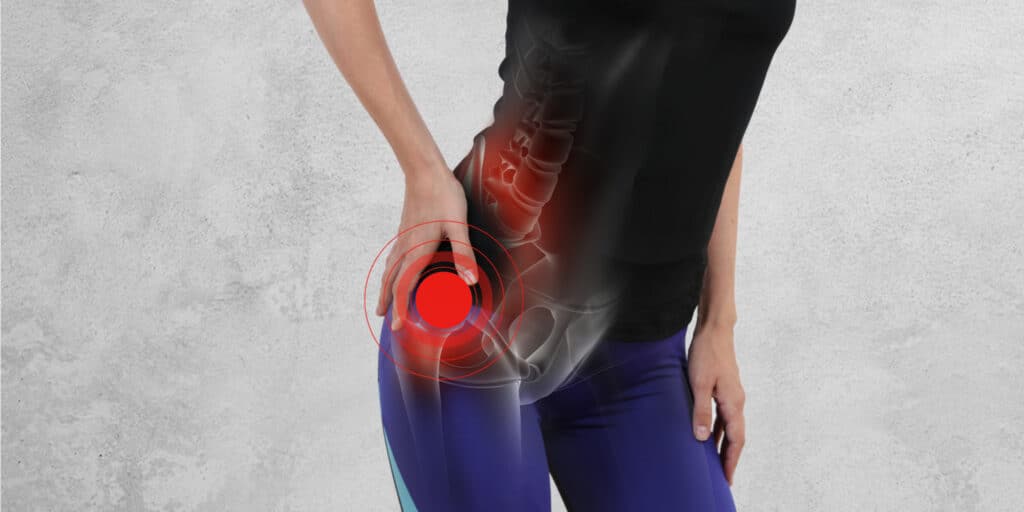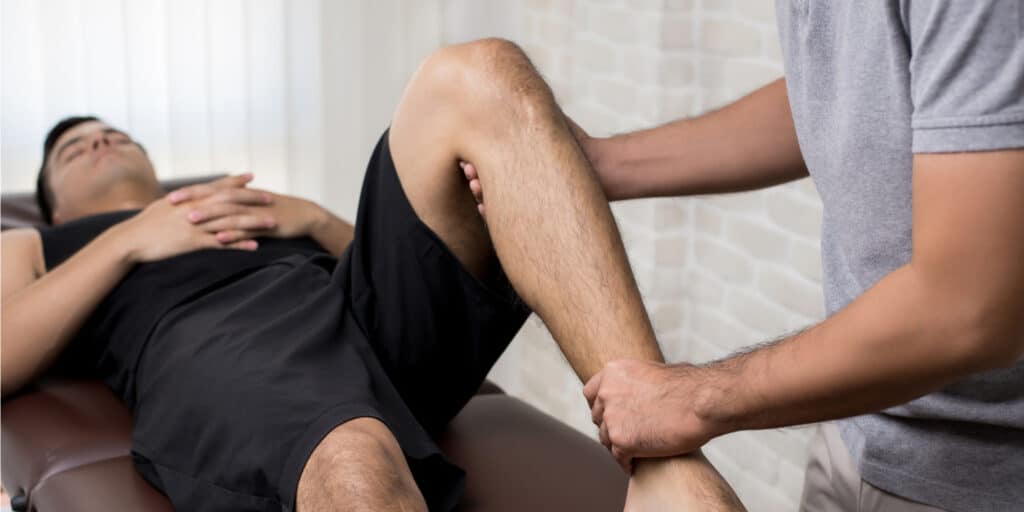One of the most aggravating types of muscle injuries is muscle strains. These types of injuries are all-too-common among those who lead active lifestyles and can be especially difficult to rehabilitate. While chances are you’re familiar with the more common types of muscle strains (hamstring, neck, shoulder, etc.), you may not be familiar with what a hip flexor strain is.
Below is everything you need to know about hip flexor strain and injuries, along with how you can treat them.
What Are Your Hip Flexors?
The hip flexors are a group of muscles that bring your legs and torso together in a flexion (bending) movement. The hip flexor muscles allow you to move your leg upwards towards your torso, as well as to bend your torso forward at the hip.
The muscles that make up your hip flexors are located around the upper and inner thighs and pelvic region. Hip flexor muscles connect at the top of the femur, the largest bone in the body, to the lower back, hips, and groin.
The muscles that make up the hip flexors include:
- Psoas Major: This is a deep muscle that connects your spine to your leg. It runs from your lower back, through your pelvis, and attaches to the top of your femur.
- Iliacus: The iliacus is a flat, triangular muscle that is found deep in your pelvis. Its primary action is to flex and rotate your thigh.
- Rectus Femoris: This muscle is one of four quadriceps muscles that attach your pelvis to the patellar tendon of your knee. Squats and lunges exercise the rectus femoris.
- Pectineus: The pectineus muscle is a flat, quadrangular muscle that is located at the top of your thigh. It is often referred to as your groin muscle. It’s primarily responsible for hip flexion.
- Sartorius: This is a long, thin muscle that runs the length of your thigh from your pelvis to your knee. The sartorius is the longest muscle in the human body and helps flex the knee and leg.
Overuse or overstretching of any of these muscles or tendons can result in injury and accompanying pain and reduced mobility. Continuing to use the hip flexors after an injury can result in a more serious injury such as a torn hip flexor, which can require specialized treatment. An important first step in treating a hip flexor injury is to understand what it feels like.
What Does a Hip Flexor Strain Feel Like?
 The most common symptom of a hip flexor injury is pain at the front of the hips. Oftentimes, people who experience hip flexor pain described pain while walking, running, bending, or squatting.
The most common symptom of a hip flexor injury is pain at the front of the hips. Oftentimes, people who experience hip flexor pain described pain while walking, running, bending, or squatting.
Common hip flexor strain symptoms include:
- Sudden, sharp pain in the hip or pelvis area, usually following some type of trauma
- Cramping or clenching sensation in the muscles of the upper leg
- Tenderness or sore feeling in the upper leg
- Loss of strength in the front of the groin
- Muscle spasms in the hips or thighs
- Discomfort when moving, including limping
- Reduced mobility when moving, and inability to continue kicking, jumping, or sprinting
Any of the above-mentioned symptoms can be a sign of hip flexor strain. If you suspect that you may be suffering from a hip flexor strain, finding the proper treatment can help expedite your recovery.
Causes of Hip Flexor Strain
The most common way someone may strain their hip flexors is through overuse. When you overuse your hip flexors, the muscles and tendons become inflamed, sore, and painful.
Some people are more susceptible to hip flexor strain than others, depending on their level of activity and muscle build.
Typically, those who experience a hip flexor strain are involved in sports. Some of the most common activities that result in a hip flexor strain include:
- Cycling
- Soccer
- Running
- Martial arts
- Dancing
- Kicking a football
That said, hip flexor injuries can be the result of non-sport-related incidents such as an accident like a slip and fall. Whatever the case may be, a hip flexor strain will most often follow a traumatic event, which can help narrow down the cause of your pain.
Hip Flexor Pain Treatment


Common hip flexor pain treatments can include any of the following:
- Rest: The most commonly prescribed treatment for a hip flexor strain is rest. It’s important to rest the affected muscles if you have a hip flexor strain. Make sure you stay off your hip as much as possible for the first few days and avoid any activities that cause or increase your pain.
- At-Home Treatments: If you’re dealing with a hip flexor strain, there’s not much that a doctor can do that you can’t already do at home. Since muscle strains don’t involve any immediate trauma that can be reminded by a physician, your best course of action is home treatments. Use ice to help relieve pain and reduce swelling in your muscles. You can also take some over-the-counter medications like ibuprofen or acetaminophen to help with pain management. If you’re worried about swelling, try wrapping the injured area with a bandage or wearing compression shorts.
- Stretching: Once your hip flexor strain has reached a manageable pain level, you may find that light stretching can help alleviate pain. Stretching your muscles can help ease tension, and make it easier to move them around. Try stretching before bed or before you start your day. Stretching is also a great way to help prevent future muscle injuries.
- Physical Therapy: If your strain is more severe, or if it is not getting better on its own, you may want to consider physical therapy. Physical therapy can help gradually stretch and strengthen your muscles, which can help you recover and prevent a future hip flexor strain.
If you notice your symptoms are not improving within a couple of weeks, or if you start having difficulty moving your legs or hips, it’s time to see a doctor. Your hip flexor strain could be more severe than you originally thought, and could require other treatments.
What Are Your Experiences With Hip Flexor Strain?
Let us know in the comments below!
What Topics Should We Cover Next?
Email us your ideas at info@painresource.com
Are You a Member of Our Online Community?




